AMD’s 5 GHz Turbo CPU in Retail: The FX-9590 and ASRock 990FX Extreme9 Review
by Ian Cutress on August 9, 2014 8:00 AM ESTCPU Benchmarks: Comparing Motherboards
Readers of our motherboard review section will have noted the trend in modern motherboards to implement a form of MultiCore Enhancement / Acceleration / Turbo (read our report here) on their motherboards. This does several things – better benchmark results at stock settings (not entirely needed if overclocking is an end-user goal), at the expense of heat and temperature, but also gives in essence an automatic overclock which may be against what the user wants. Our testing methodology is ‘out-of-the-box’, with the latest public BIOS installed and XMP enabled, and thus subject to the whims of this feature. It is ultimately up to the motherboard manufacturer to take this risk – and manufacturers taking risks in the setup is something they do on every product (think C-state settings, USB priority, DPC Latency / monitoring priority, memory subtimings at JEDEC). Processor speed change is part of that risk which is clearly visible, and ultimately if no overclocking is planned, some motherboards will affect how fast that shiny new processor goes and can be an important factor in the purchase.
Point Calculations – 3D Movement Algorithm Test: link
3DPM is a self-penned benchmark, taking basic 3D movement algorithms used in Brownian Motion simulations and testing them for speed. High floating point performance, MHz and IPC wins in the single thread version, whereas the multithread version has to handle the threads and loves more cores.
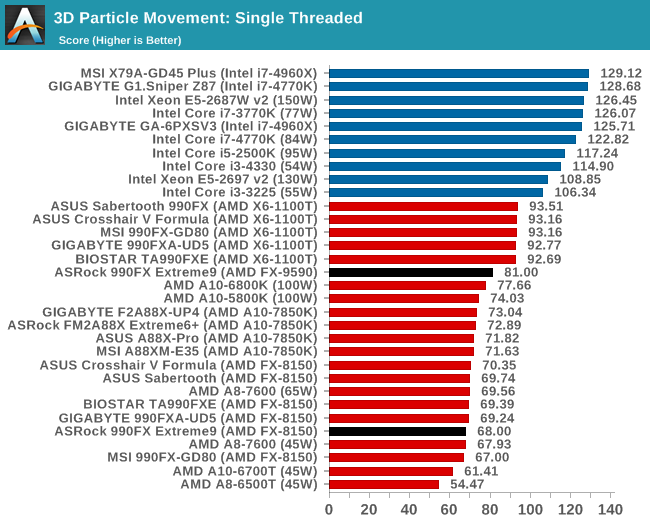

Compression – WinRAR 5.0.1: link
Our WinRAR test from 2013 is updated to the latest version of WinRAR at the start of 2014. We compress a set of 2867 files across 320 folders totaling 1.52 GB in size – 95% of these files are small typical website files, and the rest (90% of the size) are small 30 second 720p videos.
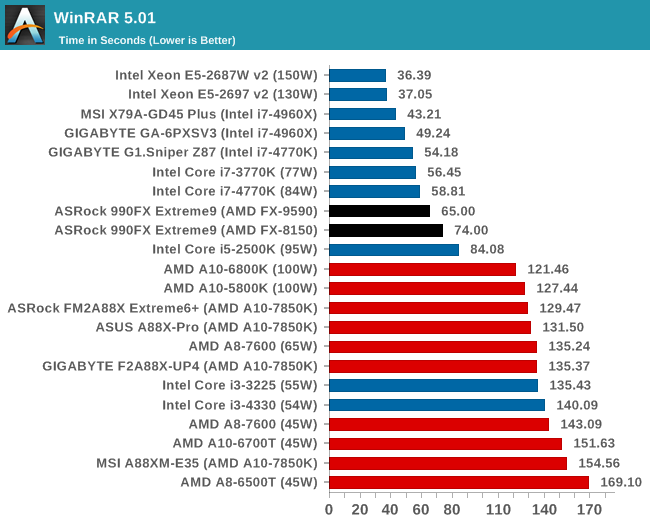
Image Manipulation – FastStone Image Viewer 4.9: link
FastStone is the program I use to perform quick or bulk actions on images, such as resizing, adjusting for color and cropping. In our test we take a series of 170 images in various sizes and formats and convert them all into 640x480 .gif files, maintaining the aspect ratio. FastStone does not use multithreading for this test, and results are given in seconds.
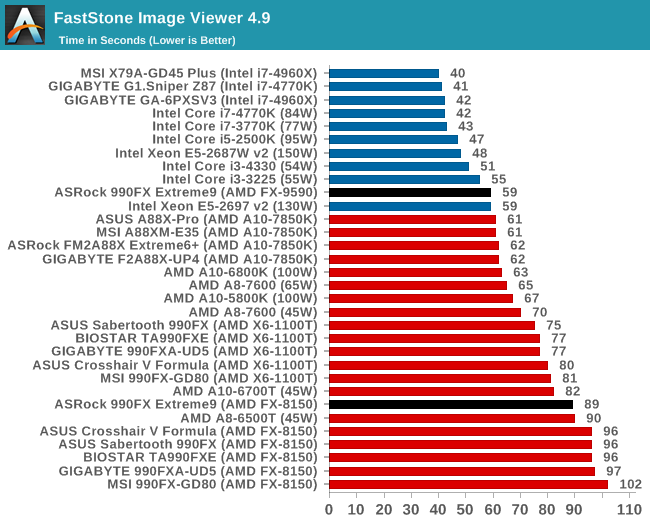
The FX-8150 result for the Extreme9 compared to other motherboards shows one of two things - the latest Windows SP1 with core parking updates has an effect, or the BIOS is more efficient at handling turbo modes than our older reviews.
Video Conversion – Handbrake v0.9.9: link
For HandBrake, we take two videos (a 2h20 640x266 DVD rip and a 10min double UHD 3840x4320 animation short) and convert them to x264 format in an MP4 container. Results are given in terms of the frames per second processed, and HandBrake uses as many threads as possible.
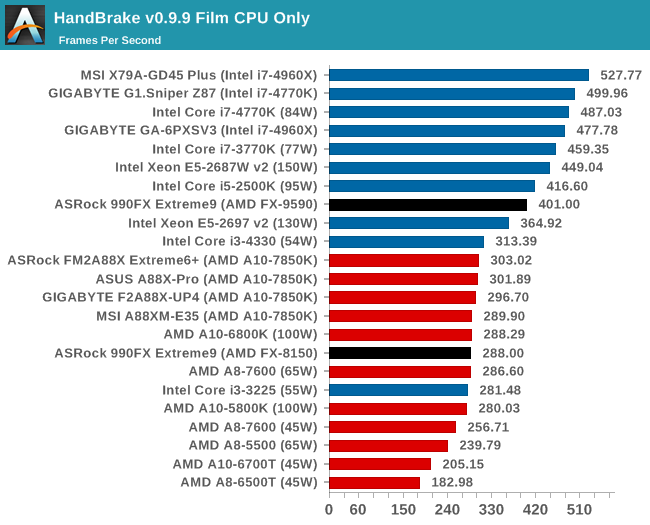

Rendering – PovRay 3.7: link
The Persistence of Vision RayTracer, or PovRay, is a freeware package for as the name suggests, ray tracing. It is a pure renderer, rather than modeling software, but the latest beta version contains a handy benchmark for stressing all processing threads on a platform. We have been using this test in motherboard reviews to test memory stability at various CPU speeds to good effect – if it passes the test, the IMC in the CPU is stable for a given CPU speed. As a CPU test, it runs for approximately 2-3 minutes on high end platforms.
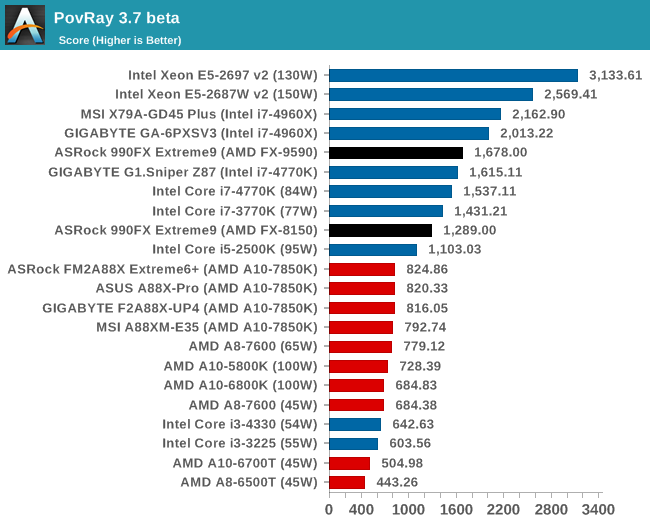
Synthetic – 7-Zip 9.2: link
As an open source compression tool, 7-Zip is a popular tool for making sets of files easier to handle and transfer. The software offers up its own benchmark, to which we report the result.
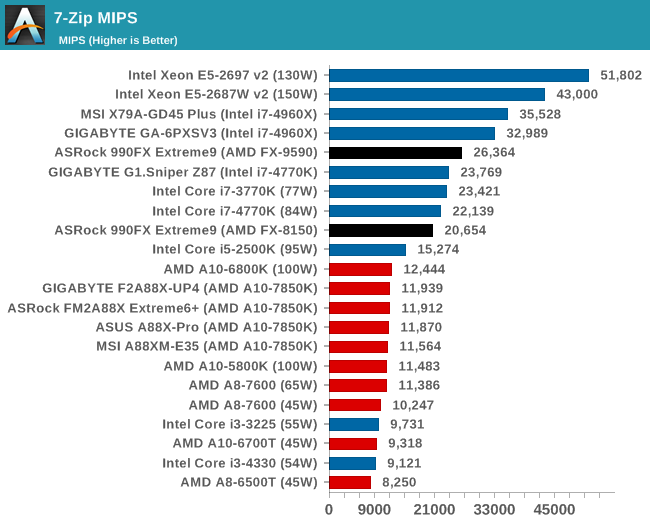










146 Comments
View All Comments
just4U - Monday, August 11, 2014 - link
I think coolermaster makes it.. Not bad, not great.. You'd be better served getting the the variant without liquid cooling (I think..) and than deciding on your own what you need.Natfly - Tuesday, August 12, 2014 - link
Garbage....you can't polish a turd.The_Riddick - Wednesday, August 13, 2014 - link
These processors really need to be running at below Intel wattage in order to be competitive, even if they tried and sold me one of these cpus for $10 I wouldn't buy one. 220W and performs worse then i5, no thanks.TiGr1982 - Wednesday, August 13, 2014 - link
Well, this same FX Piledriver certainly can run below Intel wattage (say, around 70 W for the CPU itself), but only at no more than 2.5-3.0 GHz frequency - like Opterons 6300 do.Then, it won't make a lot of sense on the desktop either :)
eanazag - Friday, August 15, 2014 - link
AMD misunderstood me.Before this product was initially released as an OEM part I had posted on an AMD article that I would be interested in a 200 W APU not CPU. I wouldn't mind an APU that could clock the GPU and CPU outrageously. I have a 300 W video card plus a 105 W Intel CPU, which the CPU is supposed to be 95 W. So a 200 W APU that comes close to both of those is a cost savings if it will clock down while idle. Plus space and heat savings.
Evidently they opted for doing it with this CPU. This is not totally bad, but between the pricing, performance, chipset features, and efficiency versus the 8350 and Intel parts it is really tough to justify. I saw numbers in there for workloads where the Haswell i3 is more than the 9590. I bought the Phenom 9600 with the errata and the CPU was fine, but I am still not willing to go that far in loyalty to AMD on the CPU side anymore. They would do better to just import the 8350/9590 silicon onto their 28 nm process. So what if it takes a clock regression as it will also have a TDP drop. They really need to do a better job updating their chipsets. This is less forgivable than their CPU line. That old, crappy 9590 would look better with a new chipset (PCIe 3 at least).
0ldman79 - Monday, August 18, 2014 - link
I've been running AMD in my desktops as a primary since the K6-2 (and K6-3+ mobile in a desktop if anyone remembers that gem).That being said, I have to call the current generation as AMD's version of the Pentium 4. I have an FX6300 in my main gaming PC. While it does well, it just isn't up to par with Intel's offerings.
I've been keeping an eye out for the next version of the AM3+ performance line and found that I've pretty much got it.
Uh... what?
AMD's flagship performance socket, AM3, has pretty much been dropped completely with all focus towards hot dual cores (seriously, that is what they are) with some rather nice integrated graphics. While I've sold several of these to my business customers I'm seriously considering jumping to Intel for my rigs.
The biggest reason is I've always had an upgrade path with AMD. It was always easy to keep building a new AMD as I'd have a couple of generations of CPU available to a platform and some of my parts from the previous system would cross. It was rarely ever a 100% replacement, more a long term evolution.
My next system will likely require a new motherboard to replace what is to me a fairly new board. With AMD effectively dropping the AM3 line just after I got onboard, I've got a sour taste in my mouth.
Those Core i7 are looking better. AMD has done this to themselves.
They took their IT customers, those that tell everyone else what to buy, told them about this awesome new CPU on the AM3 platform, the ultimate of the Bulldozer line, walked them out blindfolded for the big reveal, then walked away. We're standing there in a field of nothing with a blindfold on looking like jackasses.
That is what I think of AMD's current roadmap.
Cryio - Tuesday, August 19, 2014 - link
The absolutely BEST game for CPU benchmarking remains Crysis 3.I don't know why they use Tomb Raider and Company of Heroes which both are CPU agnostic. Not to mention that F1 series just hates AMD CPUs for whatever reason.
Games that really use the CPU: Crysis 3, Hitman Absolution, Assassin's Creed IV (I think). GRID 2, or really any mainline DIRT games. Hell, even Watch Dogs.
If any of those games that know how to properly use more than 2-4 cores were tested then this AMD beast would wipe the floor with those i3s.
Budburnicus - Wednesday, January 14, 2015 - link
LMAO!Just laughing at "This AMD "beast" would wipe the floor with those i3s." - You used beast to describe AMD's flagship product, and then talked about proper software coding allowing it to wipe the floor - wiiith i3s! LOL! just LOL!
I really am not sure if you were being sarcastic or actually meant that, but I hope it was sarcasm!
nctritech - Monday, October 20, 2014 - link
I just got an FX-9590 and an ASUS M5A99FX PRO R2.0 motherboard to go with it. I closely examined available Intel options and chose this chip. Most of the comments here put down this chip and AMD because Intel has higher-performing options and most of those comments are completely missing one vital factor: PRICE. I got this combo for $355 tax + shipping. Even if you go with the previous generation of Intel's flagship CPU, the i7-3770K, Newegg has them TODAY for $330. Hmm, that's almost as much as I paid for the FX with a brand new motherboard! Same story for the i7-4770K at $335.I walked away during a CPU sale special paying $220 total for the FX-9590 chip. It's faster in video compression benchmarks than EVERY desktop Intel chip EXCEPT the X-series i7 chips. It runs with or near the 3770K and 4770K in almost every other benchmark, possibly excluding games.
For those of you jeering at "efficiency" and praising how much faster Intel's Haswell chips can be, I wish you the best...but I'll be able to get an SSD, better RAM, or a nicer graphics card because I have $100 extra in my pocket, all while enjoying roughly the same performance as the Intel chips you've formed a cult around. Best of all, there's no LGA socket with extremely fragile pins to void my warranty; you know, when you return a mobo and they refuse to honor your return because "user-caused CPU socket pin damage" even though it was sent back because a nearby defective power component visibly burned up. Plus, did you know that CPUs only use their TDP worth of heat when you're taxing them to the maximum constantly? Who knew?!
You can have your lower performance-per-currency-unit chips and theoretical efficiency, I'll take the best overall deal, thanks!
Jinx50 - Sunday, November 2, 2014 - link
I agree enthusiast's are rarely concerned with power consumption. I quote a user i encountered who stated My Haswell is more energy efficient "meanwhile they have their rig picture with 3 Titans running in 3 way SLI for their avatar". Pure derp and a grasping desperately for the one and only straw they have in regards to downplaying the FX lineup. It's obviously neither price or performance, or multitasking for that matter.I've just become accustomed to tuning them out like annoying kids at the pub.